Input interpretation

H_2SO_4 sulfuric acid + NH_3 ammonia ⟶ (NH_4)HSO_4 ammonium bisulfate
Balanced equation
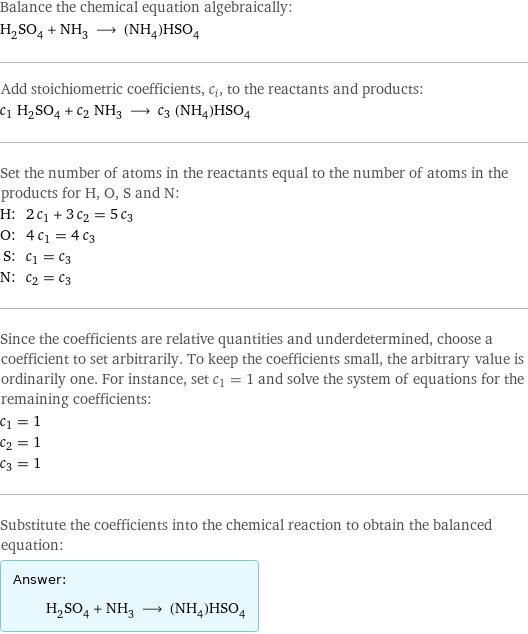
Balance the chemical equation algebraically: H_2SO_4 + NH_3 ⟶ (NH_4)HSO_4 Add stoichiometric coefficients, c_i, to the reactants and products: c_1 H_2SO_4 + c_2 NH_3 ⟶ c_3 (NH_4)HSO_4 Set the number of atoms in the reactants equal to the number of atoms in the products for H, O, S and N: H: | 2 c_1 + 3 c_2 = 5 c_3 O: | 4 c_1 = 4 c_3 S: | c_1 = c_3 N: | c_2 = c_3 Since the coefficients are relative quantities and underdetermined, choose a coefficient to set arbitrarily. To keep the coefficients small, the arbitrary value is ordinarily one. For instance, set c_1 = 1 and solve the system of equations for the remaining coefficients: c_1 = 1 c_2 = 1 c_3 = 1 Substitute the coefficients into the chemical reaction to obtain the balanced equation: Answer: | | H_2SO_4 + NH_3 ⟶ (NH_4)HSO_4
Structures
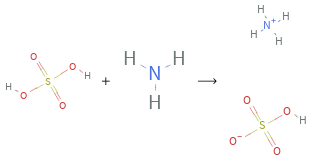
+ ⟶
Names

sulfuric acid + ammonia ⟶ ammonium bisulfate
Reaction thermodynamics
Enthalpy
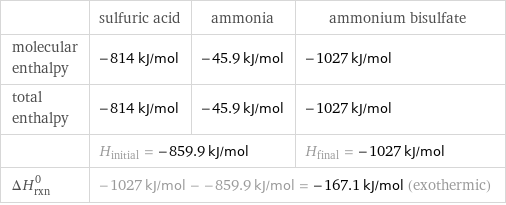
| sulfuric acid | ammonia | ammonium bisulfate molecular enthalpy | -814 kJ/mol | -45.9 kJ/mol | -1027 kJ/mol total enthalpy | -814 kJ/mol | -45.9 kJ/mol | -1027 kJ/mol | H_initial = -859.9 kJ/mol | | H_final = -1027 kJ/mol ΔH_rxn^0 | -1027 kJ/mol - -859.9 kJ/mol = -167.1 kJ/mol (exothermic) | |
Equilibrium constant
![Construct the equilibrium constant, K, expression for: H_2SO_4 + NH_3 ⟶ (NH_4)HSO_4 Plan: • Balance the chemical equation. • Determine the stoichiometric numbers. • Assemble the activity expression for each chemical species. • Use the activity expressions to build the equilibrium constant expression. Write the balanced chemical equation: H_2SO_4 + NH_3 ⟶ (NH_4)HSO_4 Assign stoichiometric numbers, ν_i, using the stoichiometric coefficients, c_i, from the balanced chemical equation in the following manner: ν_i = -c_i for reactants and ν_i = c_i for products: chemical species | c_i | ν_i H_2SO_4 | 1 | -1 NH_3 | 1 | -1 (NH_4)HSO_4 | 1 | 1 Assemble the activity expressions accounting for the state of matter and ν_i: chemical species | c_i | ν_i | activity expression H_2SO_4 | 1 | -1 | ([H2SO4])^(-1) NH_3 | 1 | -1 | ([NH3])^(-1) (NH_4)HSO_4 | 1 | 1 | [(NH4)HSO4] The equilibrium constant symbol in the concentration basis is: K_c Mulitply the activity expressions to arrive at the K_c expression: Answer: | | K_c = ([H2SO4])^(-1) ([NH3])^(-1) [(NH4)HSO4] = ([(NH4)HSO4])/([H2SO4] [NH3])](../image_source/fd5afc697002d5d9f1e6d57b3744ee9e.png)
Construct the equilibrium constant, K, expression for: H_2SO_4 + NH_3 ⟶ (NH_4)HSO_4 Plan: • Balance the chemical equation. • Determine the stoichiometric numbers. • Assemble the activity expression for each chemical species. • Use the activity expressions to build the equilibrium constant expression. Write the balanced chemical equation: H_2SO_4 + NH_3 ⟶ (NH_4)HSO_4 Assign stoichiometric numbers, ν_i, using the stoichiometric coefficients, c_i, from the balanced chemical equation in the following manner: ν_i = -c_i for reactants and ν_i = c_i for products: chemical species | c_i | ν_i H_2SO_4 | 1 | -1 NH_3 | 1 | -1 (NH_4)HSO_4 | 1 | 1 Assemble the activity expressions accounting for the state of matter and ν_i: chemical species | c_i | ν_i | activity expression H_2SO_4 | 1 | -1 | ([H2SO4])^(-1) NH_3 | 1 | -1 | ([NH3])^(-1) (NH_4)HSO_4 | 1 | 1 | [(NH4)HSO4] The equilibrium constant symbol in the concentration basis is: K_c Mulitply the activity expressions to arrive at the K_c expression: Answer: | | K_c = ([H2SO4])^(-1) ([NH3])^(-1) [(NH4)HSO4] = ([(NH4)HSO4])/([H2SO4] [NH3])
Rate of reaction
![Construct the rate of reaction expression for: H_2SO_4 + NH_3 ⟶ (NH_4)HSO_4 Plan: • Balance the chemical equation. • Determine the stoichiometric numbers. • Assemble the rate term for each chemical species. • Write the rate of reaction expression. Write the balanced chemical equation: H_2SO_4 + NH_3 ⟶ (NH_4)HSO_4 Assign stoichiometric numbers, ν_i, using the stoichiometric coefficients, c_i, from the balanced chemical equation in the following manner: ν_i = -c_i for reactants and ν_i = c_i for products: chemical species | c_i | ν_i H_2SO_4 | 1 | -1 NH_3 | 1 | -1 (NH_4)HSO_4 | 1 | 1 The rate term for each chemical species, B_i, is 1/ν_i(Δ[B_i])/(Δt) where [B_i] is the amount concentration and t is time: chemical species | c_i | ν_i | rate term H_2SO_4 | 1 | -1 | -(Δ[H2SO4])/(Δt) NH_3 | 1 | -1 | -(Δ[NH3])/(Δt) (NH_4)HSO_4 | 1 | 1 | (Δ[(NH4)HSO4])/(Δt) (for infinitesimal rate of change, replace Δ with d) Set the rate terms equal to each other to arrive at the rate expression: Answer: | | rate = -(Δ[H2SO4])/(Δt) = -(Δ[NH3])/(Δt) = (Δ[(NH4)HSO4])/(Δt) (assuming constant volume and no accumulation of intermediates or side products)](../image_source/6fe73256bad39081fb0eca995116ed12.png)
Construct the rate of reaction expression for: H_2SO_4 + NH_3 ⟶ (NH_4)HSO_4 Plan: • Balance the chemical equation. • Determine the stoichiometric numbers. • Assemble the rate term for each chemical species. • Write the rate of reaction expression. Write the balanced chemical equation: H_2SO_4 + NH_3 ⟶ (NH_4)HSO_4 Assign stoichiometric numbers, ν_i, using the stoichiometric coefficients, c_i, from the balanced chemical equation in the following manner: ν_i = -c_i for reactants and ν_i = c_i for products: chemical species | c_i | ν_i H_2SO_4 | 1 | -1 NH_3 | 1 | -1 (NH_4)HSO_4 | 1 | 1 The rate term for each chemical species, B_i, is 1/ν_i(Δ[B_i])/(Δt) where [B_i] is the amount concentration and t is time: chemical species | c_i | ν_i | rate term H_2SO_4 | 1 | -1 | -(Δ[H2SO4])/(Δt) NH_3 | 1 | -1 | -(Δ[NH3])/(Δt) (NH_4)HSO_4 | 1 | 1 | (Δ[(NH4)HSO4])/(Δt) (for infinitesimal rate of change, replace Δ with d) Set the rate terms equal to each other to arrive at the rate expression: Answer: | | rate = -(Δ[H2SO4])/(Δt) = -(Δ[NH3])/(Δt) = (Δ[(NH4)HSO4])/(Δt) (assuming constant volume and no accumulation of intermediates or side products)
Chemical names and formulas
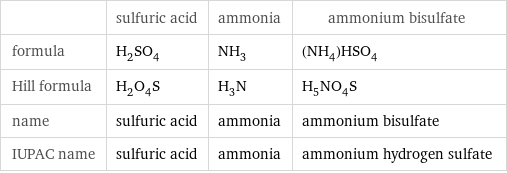
| sulfuric acid | ammonia | ammonium bisulfate formula | H_2SO_4 | NH_3 | (NH_4)HSO_4 Hill formula | H_2O_4S | H_3N | H_5NO_4S name | sulfuric acid | ammonia | ammonium bisulfate IUPAC name | sulfuric acid | ammonia | ammonium hydrogen sulfate
Substance properties
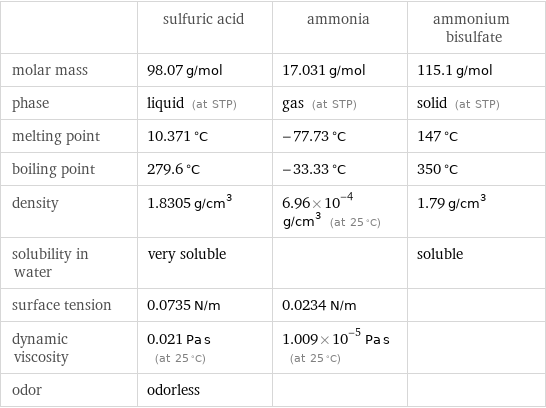
| sulfuric acid | ammonia | ammonium bisulfate molar mass | 98.07 g/mol | 17.031 g/mol | 115.1 g/mol phase | liquid (at STP) | gas (at STP) | solid (at STP) melting point | 10.371 °C | -77.73 °C | 147 °C boiling point | 279.6 °C | -33.33 °C | 350 °C density | 1.8305 g/cm^3 | 6.96×10^-4 g/cm^3 (at 25 °C) | 1.79 g/cm^3 solubility in water | very soluble | | soluble surface tension | 0.0735 N/m | 0.0234 N/m | dynamic viscosity | 0.021 Pa s (at 25 °C) | 1.009×10^-5 Pa s (at 25 °C) | odor | odorless | |
Units
